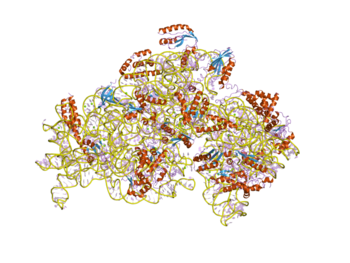| S4 | |||||||||
|---|---|---|---|---|---|---|---|---|---|
 | |||||||||
| Identifiers | |||||||||
| Symbol | S4 | ||||||||
| Pfam | PF01479 | ||||||||
| Pfam clan | CL0492 | ||||||||
| InterPro | IPR002942 | ||||||||
| PROSITE | PDOC00549 | ||||||||
| SCOP2 | 1c06 / SCOPe / SUPFAM | ||||||||
| CDD | cd00165 | ||||||||
| |||||||||
In molecular biology, S4 domain refers to a small RNA-binding protein domain found in a ribosomal protein named uS4 (called S9 in eukaryotes). The S4 domain is approximately 60-65 amino acid residues long, occurs in a single copy at various positions in different proteins and was originally found in pseudouridine syntheses, a bacterial ribosome-associated protein. [1]
Contents
The S4 protein helps to initiate assembly of the 16S rRNA. In this way proteins serve to organise and stabilise the rRNA tertiary structure. [2] [3]